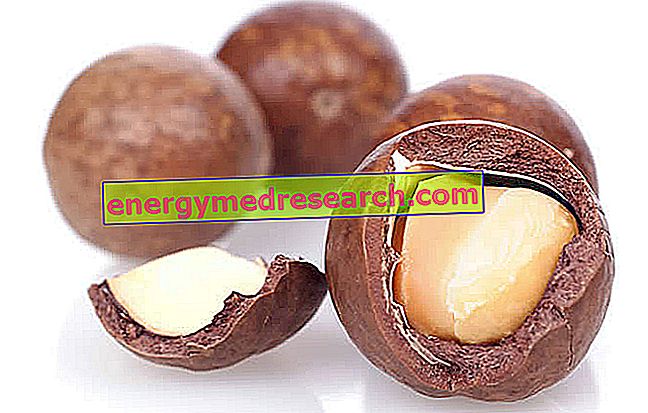What's this
The pagro - red pogry or common seabream in English - is a bony sea fish commonly used for food purposes; represents one of the largest sparids (Sparidae Family) available on the fish markets. It belongs to the genus Pagrus and to the pagrus species, and is a creature very similar to both the red-billed and pezzogna.

The pagro, like the other members of the Sparidae family, is a white fish proper. It is therefore not a question of a blue fish or even a poor fish, but it is nevertheless endowed with an excellent nutritional profile.
The pagro is part of the first fundamental group of foods - foods rich in high biological value proteins, specific vitamins and minerals; it is also an excellent source of eicosapentaenoic acid (EPA) and docosahexaenoic acid (DHA) - semi essential polyunsaturated fatty acids of the omega 3 group.
Rather thin and not too caloric, the pagro lends itself to most diets, with few exceptions almost always linked to pre-existing metabolic pathologies.
Did you know that ...
Other common sparids on the tables of the Italians are: bream, sea bream, red snapper, look, murmurs, salpa etc.
The pagro is cooked in different ways. It is excellent roasted, on the grill if small or medium in size, or in the oven if of considerable size. The fillets lend themselves to being sautéed or boiled. It is not a commonly used ingredient for frying but it is also suitable for this type of preparation.
At first glance, the pagro looks like a cross between a red sea bream and a red snapper. It is in fact red on the back and white on the belly. The mouth is well developed but without canines in evidence and the eyes are rather large. It reaches a decidedly considerable size.
Tendentially gregarious, the porgy lives almost all the year on challenging depths and in a certain period of the year it goes up for reproduction. It feeds mainly on invertebrates such as molluscs and crustaceans. It has natural predators only at a young age. It is widespread both in the Mediterranean Sea and in the Atlantic Ocean.
It can be fished professionally with bottom trawls or by mail; it is a less frequent prey in the bonito. The amateurs with the line undermine it mainly with the bottom fishing. In spearfishing it represents an occasional prey; only those who perform uncommonly can undermine it with greater confidence, since it requires them to hunt at depth to say the least, demanding.
Nutritional Properties
Nutritional properties of the porgy
The porgy is a product of fishing that falls within the first fundamental group of foods. It is not part of the category of poor fish and blue fish, while it has all the characteristics of white fish. It should however provide good levels of: semi essential polyunsaturated fatty acids omega 3 - eicosapentaenoic (EPA) and docosahexaenoic (DHA) - of vitamin D and iodine.
Despite the excellent protein intake, the porgy should be a food that is not too energetic, a nutritional characteristic mainly due to the low lipid concentration. The calories would therefore be supplied largely by peptides, followed by low concentrations of lipids and irrelevant carbohydrates. Proteins have a high biological value - they contain all the essential amino acids compared to the human model. Fatty acids are predominantly unsaturated and, as anticipated, probably characterized by an excellent level of omega-3 polyunsaturated essential biologically active seeds (EPA and DHA); any traces of carbohydrates should be soluble.
The pagro does not contain fibers, while the quantity of cholesterol is certainly relevant but not excessive. Lactose and gluten are completely absent, while the concentration of purines is abundant; histamine, absent in the fresh product, can quickly increase in poorly preserved fish. Being a highly protein food, it is also a significant source of phenylalanine amino acid.
The pagro is rich in water-soluble B vitamins, especially riboflavin (vit B2), niacin (vit PP); probably also pyridoxine (vit B6) and cobalamin (vit B12). It should also have excellent levels of fat-soluble calciferol vitamin (vit D). The levels of phosphorus and iron are appreciable; it is almost certain that it is also a significant source of zinc and iodine.
The pagro is a predatory fish that reaches large dimensions; this means that the accumulation of mercury and methylmercury in meat is consequently linked to the age and size reached. It is therefore considered necessary - especially in pregnancy - to avoid eating frequently and in large portions of large size. It is not to be excluded that, in certain oceanic areas, species similar to the hermitfish can accumulate algal toxins in the meat; it is therefore advisable to pay attention, especially during the stay abroad, to the origin of the fish.
Diet
Pork in the diet
The pagro is a food suitable for most diets. Normally digestible despite the high concentration of proteins, excessive portions may still be inadequate for those with digestive complications such as dyspepsia, gastritis, gastroesophageal reflux disease, gastric ulcer or duodenal ulcer.
The pagro lends itself to slimming diets, which must be low-calorie and normolipidic. Being very thin, in the kitchen it can be prepared using little extra virgin olive oil also in nutritional therapy against obesity.
The abundance of high biological value proteins makes the porgy ideal in the diet of malnourished, weakened or with an increased need for essential amino acids. This type of food is advisable in the case of very high intensity sports activity, especially in the disciplines of strength or with a very important muscular hypertrophied component, and for all particularly prolonged aerobic disciplines. The porgy is also suitable in the case of breastfeeding, pathological intestinal malabsorption and in old age - in which eating disorders and decreased intestinal absorption tend to create a protein deficit.
EPA and DHA, semi essential but biologically active polyunsaturated omega 3, are very important for:
- The constitution of cell membranes
- The development of the nervous system and the eyes - in the fetus and in children
- Prevention and treatment of some metabolic pathologies - hypertriglyceridemia, arterial hypertension, etc.
- The maintenance of cognitive functions in old age
- Reduction of some symptoms of neurosis - depressive - etc.
Due to the absence of gluten and lactose, the pagro is pertinent in the diet for celiac disease and for intolerance to milk sugar. The abundance of purines makes it undesirable, in considerable portions, in the nutritional regimen for hyperuricemia, especially of a serious nature - with gouty attacks - and in that of calculosis or renal urinary lithiasis. Well preserved, it has no contraindication for histamine intolerance. The massive presence of phenylalanine precludes a significant use in the diet against phenylketonuria.
The B vitamins have a mainly coenzymatic function; this is why pagro can be considered a good source of nutrients that support the cellular functions of all tissues. Vitamin D, on the other hand, is crucial for bone metabolism and the immune system. Note : we remind you that dietary sources of vitamin D are very rare.
Phosphorus, which is hardly lacking in diet, is one of the main constituents of bone (hydroxyapatite) and nervous tissue (phospholipids). Zinc constitutes enzymes, nucleic acids and proteins of various kinds. Finally, iodine is necessary for the proper functioning of the thyroid gland - responsible for the regulation of cellular metabolism after the secretion of hormones T3 and T4.
Beef is allowed in the diet during pregnancy, provided it comes from safe sources and medium-sized creatures, not large specimens - rich in mercury and methylmercury. In this case, it would still be a good idea to limit its consumption to one-off.
The average portion of pagro - as a dish - is 100-150 g.
Kitchen
How to cook the porgy?
Also in Italy the pagro is prepared raw, carpaccio or tartar; however it is more frequently used abroad as an ingredient in sashimi and other types of sushi. Obviously, for this kind of preparation, it is necessary to subject it to temperature reduction or freezing for the time necessary to eradicate the possible presence of Anisakis simplex - a parasite potentially harmful to humans.
As far as cooking is concerned, the meat of the hermit crab, even if lean, responds perfectly to all the known methods: conduction by metal, stone, water or oil - convection - hot air - radiation - from embers - and mixed.
Up to a size of 1-2 kg, the pagro lends itself to roast cooking on the grill, both with charcoal or wood embers, and with gas. Overcoming this size, it becomes an ingredient more suitable for baking in the oven, both natural, with salt or in foil - you can easily cook 10 kg in the oven, even if this requires some experience. Filleted instead, it is excellent gratin.
The pagro is also excellent filleted and sautéed in the pan, natural or with other ingredients as in the case of the acquapazza, nuanced with wine etc. Boiled or steamed boiled is a perfect example of a dietary and tasty recipe; many also appreciate it in vasocottura with few aromas, salt and pepper or chilli.
The gastronomic combination is generally with white or light rosé wines, although to get into specifics we should consider the recipe as a whole.
Description
Description of the porgy
The pagro is a fish with a moderately elongated shape and compressed on the sides. The maximum length of the specimens is 75 cm, even if on the market they are more frequent dimensions of about half. The maximum recorded size is 91 cm for 7.7 kg.
The dorsal fin of the pagro has from eleven to thirteen rigid spines and from nine to ten soft rays, while the anal fin has three spines and from seven to eight soft rays. Pectoral, ventral and caudal fins are moderately developed.
The porgy is pink to silver on the sides and white on the belly, with darker spots on the nape and behind the pectoral fins. The caudal fin is dark pink with lighter tips and the other fins are pale pink.
Biology
Outline of biology on pagro
The pagro is a bony sea fish belonging to the Sparidae family, Genus Pagrus and pagrus species.
In the basin of the Mare Nostrum it predominantly colonizes the western part, while in the Atlantic Ocean it is well present both to the east and to the west. It also lives on the eastern coasts of the Pacific Ocean.
It lives in deep bathymetries, considering the Mediterranean Sea, or medium, if instead we contextualize it in the Atlantic Ocean. Although it can reach a depth of 250 m, it is most commonly parked at depths of up to 80 m on continental shelves. It is a demersal species that prefers rocky and sandy areas. The young specimens like algae or posidonia meadows; sometimes they enter the lagoons.
It passes its existence mainly near the bottom, where it feeds on invertebrates such as molluscs and crustaceans, and small fish. It dates back to lower altitudes only once a year for the mating season; begins to reproduce at two or three years of life. Most of the specimens are protogynistic hermaphrodite - it is born female and at a certain size it becomes male; sex change is mainly related to social or environmental factors.
The pagro is an important species both for commercial and recreational fishing, in particular on the south-eastern coast of the United States, in Argentina and in the Mediterranean Sea; in Italy much less. It is captured mainly by nets, trawls and mail; secondly with bottom line. At the amateur level, it is fished above all for bottom fishing. In spearfishing it is an occasional prey reserved for a few athletes capable of reaching very demanding depths.
To date, the ocean population of the shear has decreased due to over-exploitation, but in some areas minimum size limits have been set to try to remedy this problem. The use of aquaculture was also introduced, particularly in the Mediterranean Sea and soon in North America. Overall, however, it is not considered a species at risk of extinction and the "International Union for Conservation of Nature" has assessed its conservation status as "least concern".



